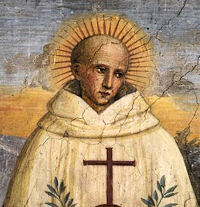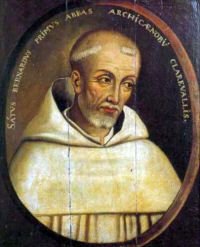Ordinary Time: August 20th
Memorial of St. Bernard, abbot and doctor
Other Commemorations: St. Bernard Tolomei (RM)
» Enjoy our Liturgical Seasons series of e-books!
St. Bernard (1090-1153) was born near Dijon and died in Clairvaux, France. He was of a noble family and received a careful education in his youth. With his father, brother and thirty noblemen he entered the Benedictine monastery of Citeaux. Two years later he led a group of monks to establish a house at Clairvaux, and became its abbot. The monastic rule which he perfected at Clairvaux became the model for 163 monasteries of the Cistercian reform. He was a theologian, poet, orator, and writer. He is sometimes considered as a Father of the Church.
St. Bernard of Clairvaux
Bernard, the second founder of the Cistercians, the Mellifluous Doctor, the apostle of the Crusades, the miracle-worker, the reconciler of kings, the leader of peoples, the counselor of popes! His sermons, from which there are many excerpts in the Breviary, are conspicuous for genuine emotion and spiritual unction. The celebrated Memorare is ascribed to him.
Bernard was born in 1090, the third son of an illustrious Burgundian family. At the age of twenty-two he entered the monastery of Citeaux (where the Cistercian Order had its beginning) and persuaded thirty other youths of noble rank to follow his example. Made abbot of Clairvaux (1115), he erected numerous abbeys where his spirit flourished. To his disciple, Bernard of Pisa, who later became Pope Eugene III, he dedicated his work De Consideratione. Bernard's influence upon the princes, the clergy, and the people of his age was most remarkable. By penitential practices he so exhausted his body that it could hardly sustain his soul, ever eager to praise and honor God.
—Excerpted from The Church's Year of Grace, Pius Parsch
Patronage: beekeepers; bees; candlemakers; chandlers; wax-melters; wax refiners; Gibraltar; Queens College, Cambridge.
Symbols and Representation: beehive; bees; three mitres on a book; white dog; inkhorn and pen; Passion implements; fettered demon; book.
Often Portrayed As: Cistercian having a vision of Mary; Cistercian with a beehive; Cistercian with a chained demon; Cistercian with a mitre on the ground beside him; Cistercian with a swarm of bees nearby; Cistercian with a white dog; Cistercian writing and watching Mary.
Highlights and Things to Do:
- Though of a rich and noble family St. Bernard continually asked the question: "For what purpose are you on earth?" Spend some time today in front of the Blessed Sacrament and ask yourself this question.
- Because St. Bernard is the patron of candlemakers, a great project would be to learn how to make candles. Candles 101 discusses in brief about making homemade candles, rolled, dipped and molded. Practicing making candles now will help in preparing to make a family Christ Candle for Advent and Paschal Candle for Easter.
- Read more about the life of St. Bernard.
- This site features hymns written by St. Bernard.
- Learn more about the Cistercian Order founded by St. Bernard.
- From the Catholic Culture library:
St. Bernard Tolomei
 Bernardo Tolomei son of Mino Tolomei, was born in Siena on the 10th of May 1272. At his baptism he was given the name Giovanni. He was probably educated by the Dominicans at their College of San Domenico di Camporegio in Siena. He was knighted by Rodolfo I d’Absburgo (d.1291). While studying law in his home town, he was also a member of the Confraternity of the Disciplinati di Santa Maria della Notte dedicated to aiding the sick at the hospital della Scala. Due to a progressive and almost total blindness, he was forced to give up his public career. In 1313, in order to realize a more radical Christian and ascetic ideal, together with two companions, (Patrizio di Francesco Patrizi d.1347 and Ambrogio di Nino Piccolomini d.1338) both noble Sienese merchants and members of the same Confraternity, he retired to Accona on a property belonging to his family, about 30km south-east of the city. It was here that Giovanni, who in the mean time had taken the name Bernardo out of veneration for the holy Cistercian abbot, together with his two companions, lived a hermitic penitential life characterized by prayer, manual work and silence.
Bernardo Tolomei son of Mino Tolomei, was born in Siena on the 10th of May 1272. At his baptism he was given the name Giovanni. He was probably educated by the Dominicans at their College of San Domenico di Camporegio in Siena. He was knighted by Rodolfo I d’Absburgo (d.1291). While studying law in his home town, he was also a member of the Confraternity of the Disciplinati di Santa Maria della Notte dedicated to aiding the sick at the hospital della Scala. Due to a progressive and almost total blindness, he was forced to give up his public career. In 1313, in order to realize a more radical Christian and ascetic ideal, together with two companions, (Patrizio di Francesco Patrizi d.1347 and Ambrogio di Nino Piccolomini d.1338) both noble Sienese merchants and members of the same Confraternity, he retired to Accona on a property belonging to his family, about 30km south-east of the city. It was here that Giovanni, who in the mean time had taken the name Bernardo out of veneration for the holy Cistercian abbot, together with his two companions, lived a hermitic penitential life characterized by prayer, manual work and silence.
Towards the end of 1318, or the beginning of 1319, while deep in prayer, he saw a ladder on which monks in white habits ascended, helped by angels, and awaited by Jesus and Mary.
In order to secure the legal position of his group, Bernardo, together with Patrizio Patrizi, visited the bishop of Arezzo, Guido Tarlati di Pietramala (1306-c.1327) under whose jurisdiction Accona fell at the time. On the 26th March 1319 he was given a Decree authorizing him to build the future monastery of Santa Maria di Monte Oliveto, and instituted “sub regula sancti Benedicti”, with certain privileges and exemptions. Through his legate, the bishop received their monastic profession. In choosing the Rule of St. Benedict, Bernardo accepted Benedictine coenobitism and, wishing to honour Our Lady, the founders wore a white habit. Welcoming the small group of monks, the bishop said: “Since your fellow citizens glory in placing themselves under the patronage of the Virgin, and because of the virginal purity of the glorious Mother, it pleases you to wear a white monastic habit, therefore showing outwardly that purity which you harbor within.” (Antonio di Barga, Cronaca 5). The white habit characterized various forms of medieval monasticism, amongst which the Camaldolese, Carthusians, Cistercians and the monks of Montevergine.
With the laying of the first stone of the church on the 1st of April 1319, the monastery of Santa Maria di Monte Oliveto Maggiore was born. The hermits became monks according to the Rule of St Bendict to which they made some institutional changes. The most characteristic element of this institutional change recorded in an episcopal document 28th March 1324, was the temporariness of the abbatial office, and the abbot-elect would have to be confirmed by the bishop of Arezzo. When the time came to elect an abbot, Bernardo succeeded in withdrawing himself from those eligible because of his infirmity of sight. Therefore, Patrizio Patrizi was elected first abbot (1st of September 1319). Two other abbots followed: Ambrogio Piccolomini (1st of September 1320) and Simone di Tura (1st of September 1321). On the 1st of September 1322, Bernardo could no longer oppose the wishes of his brethren and so became the fourth abbot of the Monastery he founded, remaining abbot until his death. An Act dated 24th September 1326 attests that the Apostolic Legate, Cardinal Giovanni Caetani Orsini (†1339), dispensed abbot Bernardo from the Canonical impediment of Infirmity of Sight, hence validating his election. From Avignone, with three Bulls dated 21st January 1344 (Significant Vestrae Sanctitati: acknowledges the foundation and requests pontifical privileges; Vacantibus sub religionis: canonical approval of the new community; Solicitudinis pastoralis officium: the faculty to erect new monasteries in Italy) Clemente VI approved the Congregation which numbered ten monasteries. Bernardo did not go to Avignone himself, but sent two monks: Simone Tendi and Michele Tani.
Significant evidence of the spiritual personality of Bernardo consists in the fact that, even though the monks had decided not to re-elect an abbot at the end of his annual mandate, they decided to ignore this, re-electing Bernardo for twenty-seven consecutive years, until his death. Another act of trust in Bernardo’s paternity was seen in the General Chapter of the 4th of May 1347 when the monks granted him the faculty to govern without recourse to the Chapter and the brethren, trusting that he would do all in conformity to God’s Will and for the salvation of all.
Bernardo tried at least twice, in 1326 and 1342, to lay down the abbatial office, declaring to the Pope’s Legate and Jurists that he was not a priest but only in Minor Orders, also citing the existing dispensation from his function as abbot because of his persistent infirmity of vision. However his leadership was asserted fully legitimate even according to the canonical norms of the time. With the Pontifical Approbation of a new Benedictine Congregation named “Santa Maria di Monte Oliveto”, Bernardo is the initiator of a resolute Benedictine monastic movement.
Bernardo left his monks an example of a holy life, the practice of the virtues to a heroic level, an existence dedicated to the service of others, and to contemplation. During the Plague of 1348 Bernardo left the solitude of Monte Oliveto for the monastery of San Benedetto a Porta Tufi in Siena. In the city, the disease was particularly dire. On the 20th August 1348, while helping his plague-stricken monks, he himself, along with 82 monks, fell victim of the Plague.
This hero of penance and martyr of charity did not go by unnoticed, as Pius XII observed in a letter sent to Abbot General Dom Romualdo M. Zilianti on the 11th April 1948, to commemorate the forthcoming sixth centenary of the death of Blessed Bernardo. The venerable abbot was buried near the monastery church in Siena. All the plague-stricken bodies were put in a common pit of quick-lime outside the church. Unfortunately the search for the bodies of the victims of the plague, both in Siena and in and around the Abbey of Monte Oliveto Maggiore, has been unsuccessful to this day.
—Excerpted from the Vatican Website
Highlights and Things to Do:








